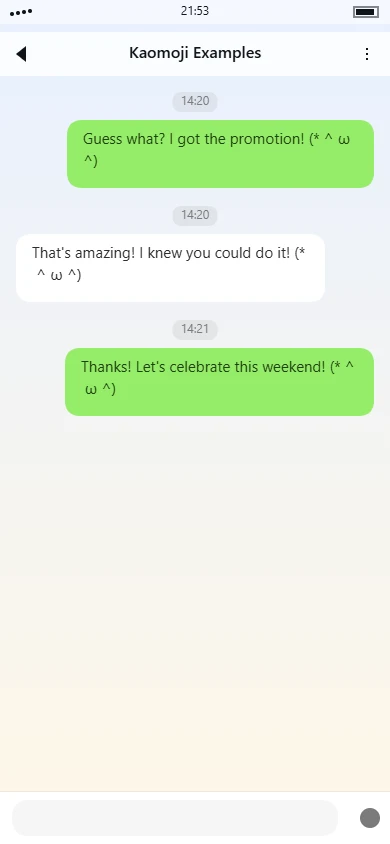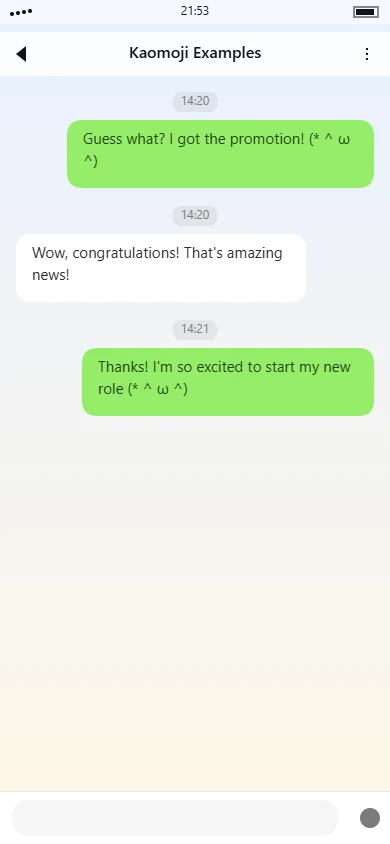`;:゛;`;・(°ε° ) kaomoji Meaning | Usage Tips

Overview
This kaomoji presents a complex facial expression built from multiple punctuation marks and diacritics arranged in a layered structure. The overall composition creates a sense of flustered embarrassment with subtle blushing elements, conveying a state of mild emotional distress or shy awkwardness.
Visual Structure Explanation
The kaomoji uses a multi-tiered approach to facial construction. On the left side, we see a cluster of punctuation marks
`;:゛;`;・(°ε° )Symbol Breakdown
- ` (backquote): Used twice in the left cluster, these likely represent sweat droplets or distressed facial features, adding to the flustered appearance
- ; : ゛ (semicolon, colon, dakuten): These punctuation marks and Japanese diacritics create texture and complexity in the left section, possibly indicating blushing cheeks or emotional turmoil
- ・ (katakana middle dot): Positioned at the end of the left cluster, this dot could represent a tear or additional distress marker
- ( ) (parentheses): Form the circular face outline on the right side, containing the main facial features
- ° (degree symbol): Used as eyes, these small circles give a wide-eyed, somewhat surprised expression
- ε (Greek epsilon): Functions as the mouth, creating a small, slightly open expression that suggests speechlessness or mild shock
Emotion & Aesthetic Analysis
The kaomoji conveys a specific type of embarrassment that's more flustered than deeply ashamed. The combination of the complex left-side cluster with the simpler right-side face creates a visual representation of someone who's been caught off guard or is experiencing mild social discomfort. The wide eyes (degree symbols) paired with the small epsilon mouth suggest surprise mixed with speechlessness, while the punctuation marks on the left add layers of emotional complexity.
Compared to simpler blushing kaomoji that might use asterisks or carets for blush marks, this version employs a more intricate approach using multiple punctuation types. The result is a more nuanced expression that sits between straightforward embarrassment and more complex emotional states like flustered confusion. This kaomoji would typically be used in situations where someone feels mildly embarrassed but not deeply ashamed - perhaps when receiving unexpected praise, making a small social mistake, or experiencing a mildly awkward situation.
Tag categories
Use tags to quickly understand this kaomoji.
Style tags
Emotion tags
Expression tags
Click tags to explore related kaomoji.
Usage guide
Usage Guide for `;:゛;`;・(°ε° )
This kaomoji presents a wonderfully expressive face that combines elements of surprise, confusion, and playful bewilderment. The combination of the tilted head (indicated by the semicolon eyes and accent marks) with the open-mouthed expression (°ε°) creates a character that's caught off guard but in a lighthearted way. It's perfect for those moments when you're genuinely surprised by something but want to maintain a friendly, approachable tone. You'll often see this kaomoji used in casual online conversations where friends share unexpected news, funny coincidences, or situations that defy expectations.
The beauty of this expression lies in its versatility - it can convey everything from "Wait, what?" to "No way!" without coming across as too dramatic or intense. The slightly messy arrangement of characters gives it an organic, spontaneous feel that works well in quick chats, social media comments, and gaming communities. It's particularly effective when you want to show that you're processing new information while remaining engaged in the conversation.
Common Use Cases
- Reacting to a friend's unexpected life update in a group chat
- Expressing surprise when someone reveals a hidden talent or skill
- Responding to plot twists in movies, books, or TV shows being discussed online
- Showing playful confusion when someone tells a joke with an unexpected punchline
- Reacting to surprising gaming moments or unexpected in-game events
- Expressing amused bewilderment at strange coincidences or "small world" stories
- Responding to food pictures that look surprisingly delicious or creatively presented
- Showing surprise mixed with curiosity when learning new facts or trivia
- Reacting to fashion choices or makeup looks that are unexpectedly stylish
- Expressing playful shock when friends share embarrassing but funny childhood stories
- Responding to memes or viral content that takes an unexpected turn
- Showing amused surprise when pets do something unusually clever or funny
Example Conversations
-
Friend sharing news: "Guess who just got a promotion at work?" "Wait, really? `;:゛;`;・(°ε° ) That's amazing! You only started there three months ago!"
-
Gaming context: "I just found a secret room behind the waterfall" "`;:゛;`;・(°ε° ) No way! I've played this game for years and never knew about that!"
-
Social media interaction: "Turns out we went to the same elementary school but never knew each other" "`;:゛;`;・(°ε° ) Seriously? What are the chances of that happening?"
-
Movie discussion: "The main character was the villain's brother the whole time" "`;:゛;`;・(°ε° ) Mind blown! I need to rewatch it with that in mind"
-
Food conversation: "I made this cake using only three ingredients" "`;:゛;`;・(°ε° ) Three ingredients? It looks like it came from a professional bakery!"
-
Personal revelation: "I used to be a competitive figure skater before college" "`;:゛;`;・(°ε° ) What? You never mentioned that! That's so cool!"
Important Notes
-
Avoid using this kaomoji in professional emails or formal business communications, as it may come across as too casual or unprofessional for serious contexts.
-
While this expression conveys surprise, it maintains a positive and engaged tone rather than negative shock or alarm, making it suitable for most friendly interactions.
-
The kaomoji works best when you genuinely want to express pleasant surprise rather than sarcastic disbelief, as the facial expression reads as authentically curious rather than mocking.
This kaomoji has become particularly popular in gaming communities and anime-focused spaces, where exaggerated but friendly reactions are common and appreciated. Its balanced combination of surprise and approachability makes it a versatile choice across different casual online platforms.
When used appropriately, this kaomoji can help convey your genuine reaction while keeping the conversation light and engaging. It's particularly effective for building rapport in online communities where shared reactions to surprising content help strengthen social bonds. The expression strikes a nice balance between showing genuine surprise and maintaining a friendly, curious demeanor that invites further conversation rather than shutting it down.
Usage examples
Real conversation samples that feature this kaomoji.

Example 1

Example 2
Related kaomoji
You might also enjoy these kaomoji.